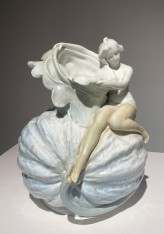WAHLISS Ernst
WAHLISS Ernst
Ernst Wahliss, born in 1836 and passing away in 1900, was a renowned Austrian artist of the 19th century. A notable collaborator of Karl Klaus and other artists, Wahliss left a lasting impact on Vienna's art history from the late 1880s. As a prosperous merchant, he established himself as Vienna's leading retailer of porcelain and ceramics. Since 1863, he managed a ceramic shop in Vienna, whose rapid international success enabled him to open stores in major European cities such as London, supplying high-quality ceramics to numerous European royal families.
In 1894, Ernst Wahliss acquired the Alfred Stellmacher factory in Turn-Teplitz, Bohemia (now in the Czech Republic), and began producing decorative ceramics under the name "Ernst Wahliss Kunst, Porzellan und Fayence Fabrik."
After Ernst's death in 1900, his son Gerhard Martin Wahliss took over the factory in 1907 and continued to create a variety of functional and decorative items in earthenware and porcelain. The Serapis-Wahliss line, introduced in 1911, was made of white earthenware and adorned with geometrically stylized natural forms such as blossoms and peacock feathers. Hand-painted with richly colored enamels, these decorations represented the avant-garde in Austrian ceramics at the time. Designers like Karl Klaus, who had studied under Josef Hoffmann, brought a rare delicacy and urban sophistication to Wahliss's aesthetic blueprint. After decades of artistic influence, Wahliss's legacy endures through his son's creations and the ongoing recognition of his impact on Vienna's art scene.

